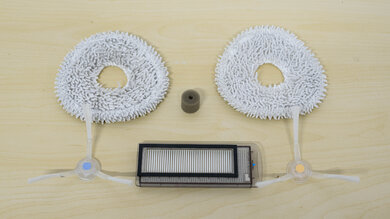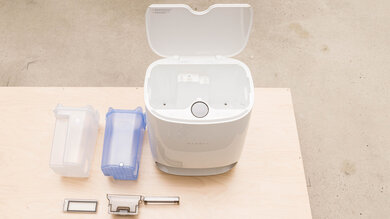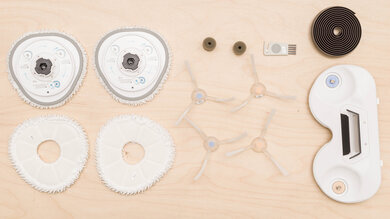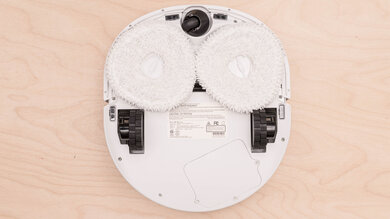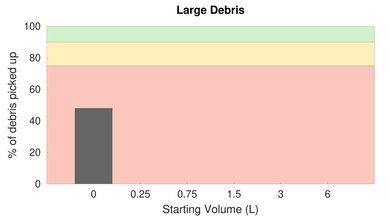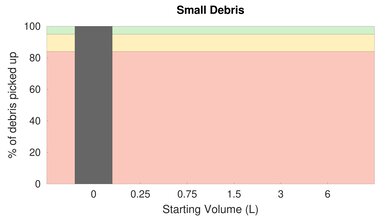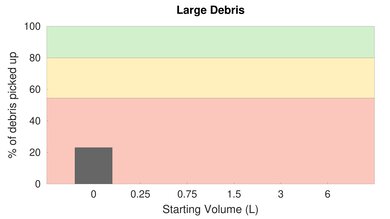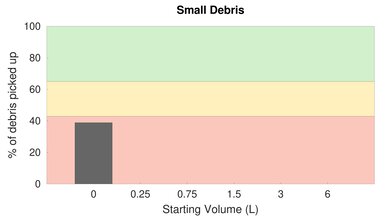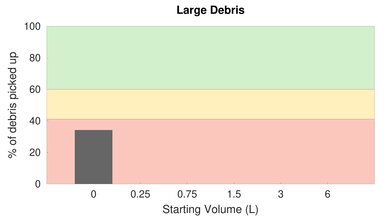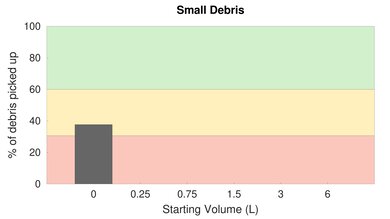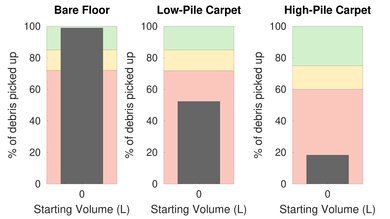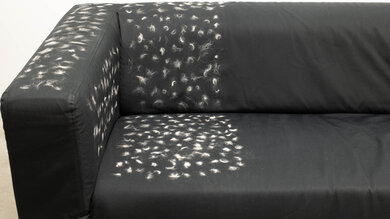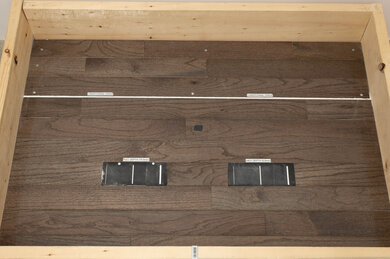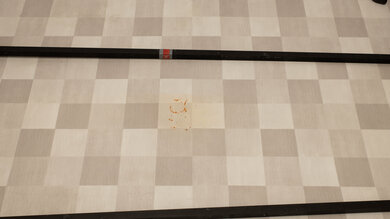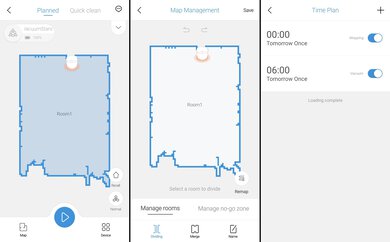The Narwal T10 is a uniquely designed hybrid robot mop/vacuum. It comes with separate mopping and vacuuming modules, which you can swap out for one another very easily. Unlike many other robot vacuums/mops, its mopping pads actually move, as opposed to being static cloths. Its docking station cleans and dries its mopping pads, so it shouldn't track dirty water around your home while mopping. That said, its vacuuming configuration is somewhat underbaked, with no brushroll to provide some level of surface agitation.
Our Verdict
The Narwal T10 is decent for bare floors. It has no trouble clearing away small debris like rice, though bulkier material like cereal can clog its small suction inlet. It feels well-built, offers superb battery performance, and maneuvers itself fairly effectively. The mopping module is easy to install and does a great job of scrubbing away dried-on stains.
- Effective mopping system.
- Excellent build quality.
- Superb battery performance.
- Wide range of automation features.
- High recurring costs.
- Demanding maintenance requirements.
- Bulky debris can clog suction inlet.
The Narwal T10 is okay for low-pile carpet. Its lack of a brushroll means it has a very hard time sucking up fine and large debris embedded within carpet fibers. That said, it does feel amazingly well-built and has a very long battery life, so it can clean large spaces without running out of charge. While there's no automatic surface detection system, the vacuum has a set of magnetic boundary strips that you can put in place to prevent it from moving onto carpets while mopping.
- Excellent build quality.
- Superb battery performance.
- Wide range of automation features.
- Includes magnetic strips to avoid mopping carpets.
- High recurring costs.
- Demanding maintenance requirements.
- Struggles with pet hair on carpeted surfaces.
- Poor overall performance on carpeted floors.
The Narwal T10 is a mediocre option for cleaning high-pile carpet, though this isn't its intended use case. It doesn't have a brushroll to agitate carpet fibers, so it struggles with sucking up pet hair, fine debris, and larger material. It can also sometimes struggle to climb onto higher-pile carpets and occasionally gets stuck on rug tassels.
- Excellent build quality.
- Superb battery performance.
- Wide range of automation features.
- Includes magnetic strips to avoid mopping carpets.
- High recurring costs.
- Demanding maintenance requirements.
- Struggles with pet hair on carpeted surfaces.
- Poor overall performance on carpeted floors.
The Narwal T10 is disappointing when it comes to dealing with pet hair. While it has no issue dealing with pet hair on bare floors, it delivers poor pet hair cleaning performance on low and high-pile carpet due to the lack of a brushroll. Conversely, the absence of a brushroll means that you don't need to worry about hair wraps, and it has an onboard HEPA filter to trap allergens as it cleans. It's also very quiet, so it shouldn't be too disruptive for animals that are unnerved by loud noises.
- Excellent build quality.
- Wide range of automation features.
- High recurring costs.
- Demanding maintenance requirements.
- Struggles with pet hair on carpeted surfaces.
The Narwal T10 is a robot vacuum and isn't meant for cleaning stairs.
The Narwal T10 is a robot vacuum and isn't designed to clean the inside of your car.
The Narwal T10 isn't designed for workshop cleaning.
Changelog
- Updated Sep 24, 2024: We've added a link to the Narwal Freo X Ultra in the 'Physical Automation' section of the review to provide an alternative with a more developed set of automation capabilities.
- Updated Dec 06, 2022: We've corrected an input error in the 'Wet Compatible' field in the 'Water' box.
- Updated Sep 26, 2022: We've updated this review to Test Bench 0.6, which includes a broad range of new testing procedures to measure stain and water-clearing performance, suction power, crevice-cleaning performance, noise levels, and air filtration performance. We've also updated our debris and pet hair-pickup performance tests as well as our method of scoring user maintenance requirements, recurring costs, dirt compartment sizing, and suitability for the 'Workshop' usage section.
- Updated Sep 07, 2022: Converted to Test Bench 0.6.
Check Price
Differences Between Sizes And Variants
The Narwal T10 is only available in one variant: White, and you can see our test unit's label here.
Let us know in the comments if you come across another variant of this vacuum, and we'll update our review.
Popular Robot Vacuum Comparisons
The Narwal T10 is a premium hybrid robot mop/vacuum. Unlike other hybrid robot vacuum/mops like the Roborock S7, this vacuum doesn't have an onboard water reservoir for wetting its mopping pads. Instead, it periodically returns to its docking station, which sprays its mopping pads with clean water from an onboard reservoir, cycles the wastewater to a separate tank, and air dries the pads to prevent mildew buildup, which should reduce hands-on maintenance requirements. However, to accommodate its easily swappable vacuum module, it doesn't have a brushroll, so its performance on carpets is poor overall.
If you're looking for alternatives, see our recommendations of the best robot vacuums, the best robot vacuums for hardwood floors, and the best robot vacuums for pet hair.
The Ecovacs DEEBOT OZMO T8 AIVI is a better robot vacuum than the Narwal T10. The Ecovacs incurs fewer recurring costs, is easier to store, and delivers superior vacuuming performance on all surface types. Unlike the Narwal, it's capable of vacuuming and mopping simultaneously. While the Ecovacs does have a longer battery life, the Narwal can charge in less than a third of the time. The Narwal's mopping system, with its rotating pads and self-cleaning system, is also far more effective in dealing with stains than the Ecovacs' onboard water reservoir and static mop cloths.
The iRobot Roomba S9 is a better robot vacuum than the Narwal T10. The iRobot has a much larger internal dustbin, can maneuver around or over obstacles like rugs more effectively, and clears more debris on almost all surface types. However, the Narwal does have a mopping system for dealing with messes on bare floors. Its LIDAR mapping system also allows it to navigate far more easily than the iRobot in the dark.
The Narwal T10 and the Roborock S7 each have their advantages, meaning one may suit you better than the other, depending on your needs. The Narwal has a more advanced mopping system, with a unique self-cleaning system built into its docking station. It also charges faster, though the Roborock does have a slightly longer battery life. In addition, the Roborock does a better job of vacuuming debris on bare floors as well as low- and high-pile carpets and can maneuver itself more effectively.
The Roborock S6 MaxV is better at vacuuming than the Narwal T10. The Roborock has a much larger internal dustbin, can automatically adjust its brushroll speed depending on the surface type that it's on, and delivers superior performance on all surface types. Meanwhile, instead of the Roborock's static cloth pads for mopping, the Narwal has a far more robust mopping system, with rotating cloth pads that provide a more thorough clean. Its docking station has a built-in cleaning and drying system for its mopping pads that should significantly reduce the chances of it tracking dirty water around your home. In addition, the Narwal charges much faster and lasts roughly as long as the Roborock on a single charge.
Test Results

The Narwal T10 is amazingly well-built. It's made of high-grade plastic that looks and feels premium. The glossy top cover can be removed to let you access the dirt compartment and the power button. Unlike most robot vacuums, it doesn't have a brushroll and instead uses twin side brushes to direct debris into a suction inlet. The side brushes are part of an vacuum module that can be easily removed and swapped with a mopping module for use on bare floors. The vacuum itself feels quite sturdy for the most part, though the small internal dustbin could break if you were to drop it. Its base station is also solidly-built and features an LED screen that shows the vacuum's current status.
Out-of-the-box setup is quite easy, though you should download its companion app to access its full capabilities.
The Narwal T10 has quite a few maintenance needs, though most of its components are easy to access.
- Dirt compartment: You can access the dirt compartment by lifting the vacuum's top cover and then pulling it out of its housing with its built-in carrying handle. You should empty it after every cleaning session by unlocking the release buckles while holding it over a trash can.
- HEPA Filter: The filter is located inside the internal dirt compartment. You should wash it under water every two weeks.
- Side brushes: The side brushes are attached to the vacuum module but can be pulled free. Make sure to cut away any tangled hair or stuck-on debris with the included hook blade every two weeks. If necessary, you can also wash them, along with the vacuum module attachment, with water.
- Caster wheel: The directional wheel can be pulled out of the socket. Remove any stuck-on debris once a month.
- Mop pads: The vacuum returns to its base station, where the mopping pads are washed and dried by a series of built-in water nozzles and air inlets, so they're considered to be self-cleaned. You can pull the mopping pads off and remove any stuck-on debris if necessary.
- Water tanks: This vacuum's base station features two water tanks, one for clean water and the other for waste water. They can be pulled out very easily for refilling or cleaning. The clean water tank should be cleaned every three months and refilled once it's empty. Meanwhile, you should clean the waste water tank at the end of every mopping session.
- Water tank sponge filter: The sponge filter is located inside the clean water tank and can only be accessed after you empty it. You should clean it every three months in conjunction with the clean water tank.
Any part washed with water should be allowed to dry for at least 24 hours before being put back in the vacuum.
The Narwal T10 incurs moderately high recurring costs.
- Side brushes: You should replace the side brushes every three months. You can purchase them in packs of two from the manufacturer's website.
- HEPA filter: You should replace the filter every three to six months, depending on your usage habits. You can buy replacements in packs of two from the manufacturer.
- Mopping pads: You should replace the mopping pads every three months. You can purchase them from the manufacturer's website in packs of two.
- Water tank sponge filter: No specific replacement interval is given in the user manual, but it states that you should clean or replace it periodically.
The Narwal T10 has excellent storage capabilities. While the docking station is somewhat large, the vacuum is stored almost entirely inside it, reducing its overall footprint.
The Narwal T10 has a small internal dustbin. It needs to be emptied more frequently than other robot vacuums like the Roborock S7. On the other hand, if you plan on using its mop attachment, its external clean water tank has a fairly large capacity of 1.25 gallons, so you shouldn't need to refill it very often.
- Narwal T10 vacuum
- Robot vacuum body
- Internal dirt compartment
- 1x T10 HEPA filter
- Vacuum module
- 4x side brushes
- Mopping module
- 4x mopping pads
- Hook blade cleaning tool
- Magnetic strip
- Operational Manual
- Base station
- Base station
- Clean water tank
- Waste water tank
- 2x clean water tank sponge filters
- Power cord
The Narwal T10's range is limited only by the room left in its dirt compartment and its remaining battery life. However, it can't climb or descend stairs.
The Narwal T10 is quite portable. It weighs slightly less than alternatives like the Roborock S7, though it doesn't have a carrying handle to make it easier to pick up and carry.
Note: This vacuum is slightly heavier with the mopping module. It weighs 8.97 lbs (4.07 kg) with the mopping pads fitted in place.
The Narwal T10 has superb battery performance. Running it in its high-power 'Turbo' mode with the vacuum module yields over 130 minutes of runtime, while it should run for over 170 minutes when using it in its default 'Normal' suction mode with the vacuum module attached. It's fairly close to its advertised battery life of three hours.
The Narwal T10 has a couple of quality-of-life features. Aside from its mopping capability, it has two suction power levels that you can change through its companion app: the default 'Normal' mode and the high-power 'Strong' mode. That said, unlike the Roborock S7 MaxV, there's no automatic surface detection system that would allow it to avoid carpets when mopping; you'll need to block off these areas manually with the magnetic strips included in the box. The base station also has a small LED screen that shows the vacuum's current task, an estimate of remaining time until completion, battery life, and whether or not you've enabled the child lock.
The Narwal T10 has a vacuum module with two side brushes that direct debris into the path of its suction inlet, and two spare side brushes are included. You can swap out the vacuum module for the mopping module, which comes preinstalled with two mopping pads. It also comes with two extra mopping pads. There's also a hook blade tool to remove any stuck-on debris from the side brushes.
The Narwal T10 performs decently on bare floors. It's very effective in dealing with smaller debris like rice. However, its lack of a brushroll and comparatively small suction inlet can result in bulkier debris like cereal getting stuck and clogging the opening.
The Narwal T10 performs inadequately on low-pile carpet. Due to its lack of a brushroll, it can't provide the necessary agitation to dislodge large and fine debris like sand or baking soda from carpet fibers, even in its most powerful 'Strong' suction mode.
The Narwal T10 has middling performance on high-pile carpet. The lack of a brushroll means that it doesn't have the necessary means of working materials like sand and baking soda free of carpets.
The Narwal T10's suction force isn't very strong compared to high-end models like the Roborock S7 MaxV. Its suction inlet is also positioned too high above the contact surface to generate a tight seal on bare surfaces, resulting in low suction power measurements.
The Narwal T10 is remarkably quiet when cleaning. With no brushroll to rub against the ground, it makes considerably less noise than most other robot vacuums. You'll hear what people nearby are saying even when the vacuum is running in its most powerful suction mode.
The Narwal T10 is good at maneuvering itself. It begins cleaning by moving around the room's perimeter before vacuuming small sections of its coverage area. Swapping between the mopping and vacuum modules is easy and only takes a couple of seconds. It's also small enough to fit under tables and chairs, though only just. Unfortunately, it can struggle to climb onto high-pile carpets, and rug tassels can get caught on its side brushes.
Its mopping capability is quite impressive, as it cleans its mopping pads throughout its cleaning job rather than tracking dirty water around your house and has an air-drying system built into its docking station to prevent mildew buildup on the pads. However, while the vacuum can recognize which module is in use, it's still important you set up the included magnetic strips around carpets or any other surface you don't want to get wet. You can see a video of its mopping maneuverability here.
The Narwal T10 does a good job of sealing in fine particles thanks to its onboard HEPA filter.
Due to its low suction force, the Narwal T10 does a poor job sucking up debris from cracks and crevices. Using it in its high-power 'Strong' mode does little to improve its performance in this regard, as seen here.
The Narwal T10 delivers impressive stain-clearing performance. Installing the mop pads is very easy. It takes about 90 seconds for the base station to thoroughly wet its mopping pads and let it start cleaning. While it can lift away most of a stain without streaks on a single go-around, it's recommended you allow it to make a second pass since the appliance will return to its base station to re-clean its pads. You can see the results of the Narwal clearing a stain with two passes here.
The Narwal T10's physical controls are a little limited. You can have the vacuum start cleaning without its companion app by using the control button, though you can only access most of its control parameters in its companion app. Consider the Narwal Freo X Ultra if you want something with a wider range of automation capabilities.
This vacuum has a great companion app. It's pretty responsive and intuitive to navigate. The appliance itself uses a LIDAR sensor to draw a map of its coverage area as it progresses through its current task. You can use the app to set up no-go zones, set up individual cleaning areas and sequence cleaning sessions, check the vacuum's battery status, and enable or disable the child lock.



